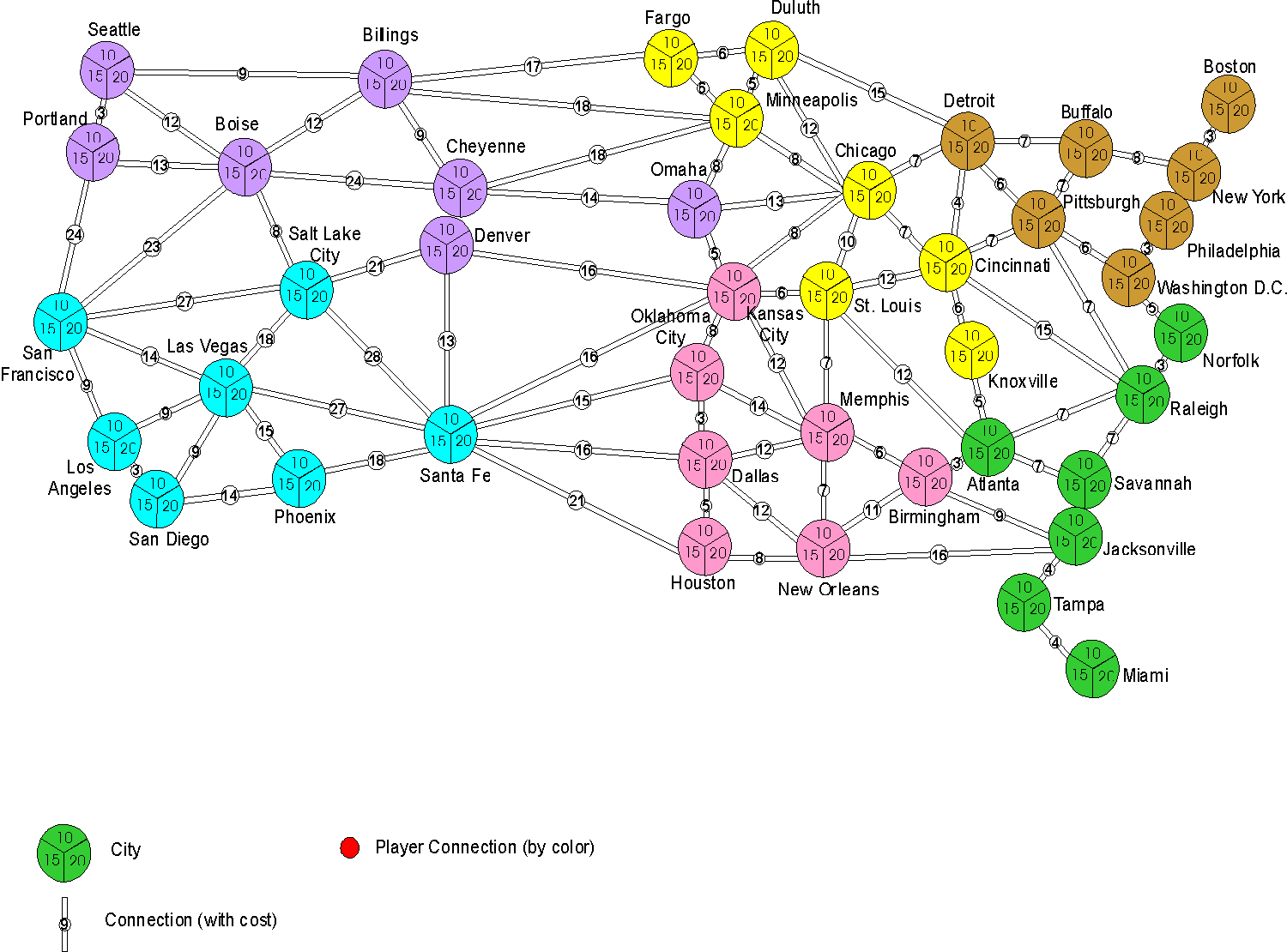
Power Grid Player Aid
Table of Contents
|
Number |
Type |
Inputs |
Output |
|
3 |
Oil |
2 |
1 |
|
4 |
Coal |
2 |
1 |
|
5 |
Hybrid |
2 |
1 |
|
6 |
Garbage |
1 |
1 |
|
7 |
Oil |
3 |
2 |
|
8 |
Coal |
3 |
2 |
|
9 |
Oil |
1 |
1 |
|
10 |
Coal |
2 |
2 |
|
11 |
Nuclear |
1 |
2 |
|
12 |
Hybrid |
2 |
2 |
|
13 |
Ecological |
N/A |
1 |
|
14 |
Garbage |
2 |
2 |
|
15 |
Coal |
2 |
3 |
|
16 |
Oil |
2 |
3 |
|
17 |
Nuclear |
1 |
2 |
|
18 |
Ecological |
N/A |
2 |
|
19 |
Garbage |
2 |
3 |
|
20 |
Coal |
3 |
5 |
|
21 |
Hybrid |
2 |
4 |
|
22 |
Ecological |
N/A |
2 |
|
23 |
Nuclear |
1 |
3 |
|
24 |
Garbage |
2 |
4 |
|
25 |
Coal |
2 |
5 |
|
26 |
Oil |
2 |
5 |
|
27 |
Ecological |
N/A |
3 |
|
28 |
Nuclear |
1 |
4 |
|
29 |
Hybrid |
1 |
4 |
|
30 |
Garbage |
3 |
6 |
|
31 |
Coal |
3 |
6 |
|
32 |
Oil |
3 |
6 |
|
33 |
Ecological |
N/A |
4 |
|
34 |
Nuclear |
1 |
5 |
|
35 |
Oil |
1 |
5 |
|
36 |
Coal |
3 |
7 |
|
37 |
Ecological |
N/A |
4 |
|
38 |
Garbage |
3 |
7 |
|
39 |
Nuclear |
1 |
6 |
|
40 |
Oil |
2 |
6 |
|
42 |
Coal |
2 |
6 |
|
44 |
Ecological |
N/A |
5 |
|
46 |
Hybrid |
3 |
7 |
|
50 |
Fusion |
N/A |
6 |
|
Supplied Cities |
Elektros |
|
0 |
10 |
|
1 |
22 |
|
2 |
33 |
|
3 |
44 |
|
4 |
54 |
|
5 |
64 |
|
6 |
73 |
|
7 |
82 |
| 8 | 90 |
| 9 | 98 |
| 10 | 105 |
| 11 | 112 |
| 12 | 118 |
| 13 | 124 |
| 14 | 129 |
| 15 | 134 |
| 16 | 138 |
| 17 | 142 |
| 18 | 145 |
| 19 | 148 |
| 20+ | 150 |

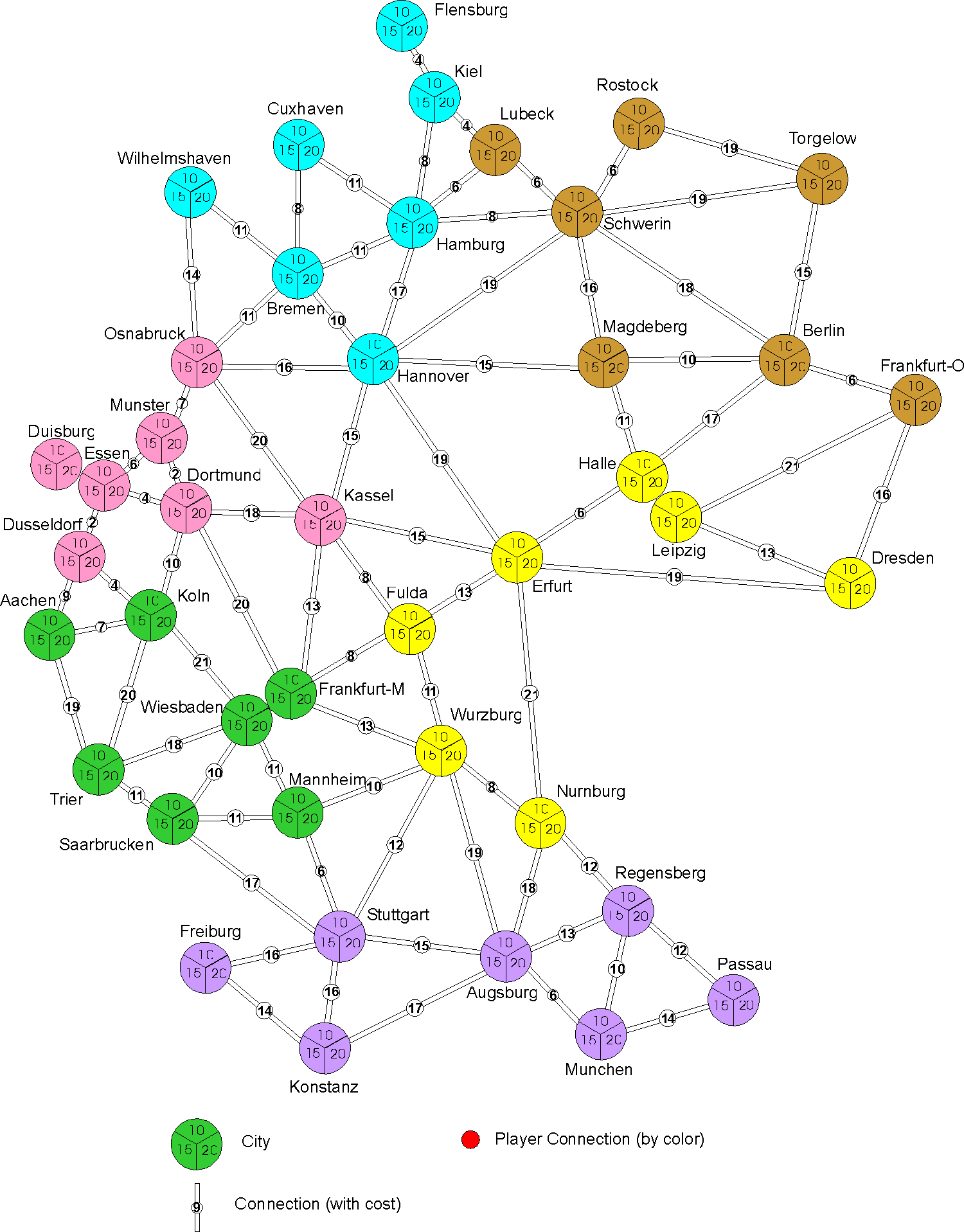
Resource Replenishment
|
2 Players |
3 Players |
4 Players |
5 Players |
6 Players |
|||||||||||
|
Step 1 |
Step 2 |
Step 3 |
Step 1 |
Step 2 |
Step 3 |
Step 1 |
Step 2 |
Step 3 |
Step 1 |
Step 2 |
Step 3 |
Step 1 |
Step 2 |
Step 3 |
|
|
Coal |
3 | 4 | 3 | 4 | 6 | 3 | 5 | 6 | 4 | 5 | 7 | 5 | 7 | 9 | 6 |
|
Oil |
2 | 2 | 4 | 2 | 3 | 4 | 3 | 4 | 5 | 4 | 5 | 6 | 5 | 6 | 7 |
|
Garbage |
1 | 2 | 3 | 1 | 2 | 3 | 2 | 3 | 4 | 3 | 3 | 5 | 3 | 5 | 6 |
|
Uranium |
1 | 1 | 1 | 1 | 1 | 1 | 1 | 2 | 2 | 2 | 3 | 2 | 2 | 3 | 3 |
Expansions

Special Rules for France
Due to France's emphasis on nuclear power, the following special rules are in effect.
1. Power plant 13 is removed from the game.
2. Power plant 11 is set aside in place of power plant 13, and placed at the top of the deck after it has been shuffled.
3. When the resources are initially set up, uranium is filled down to a price of 5 Elektros.
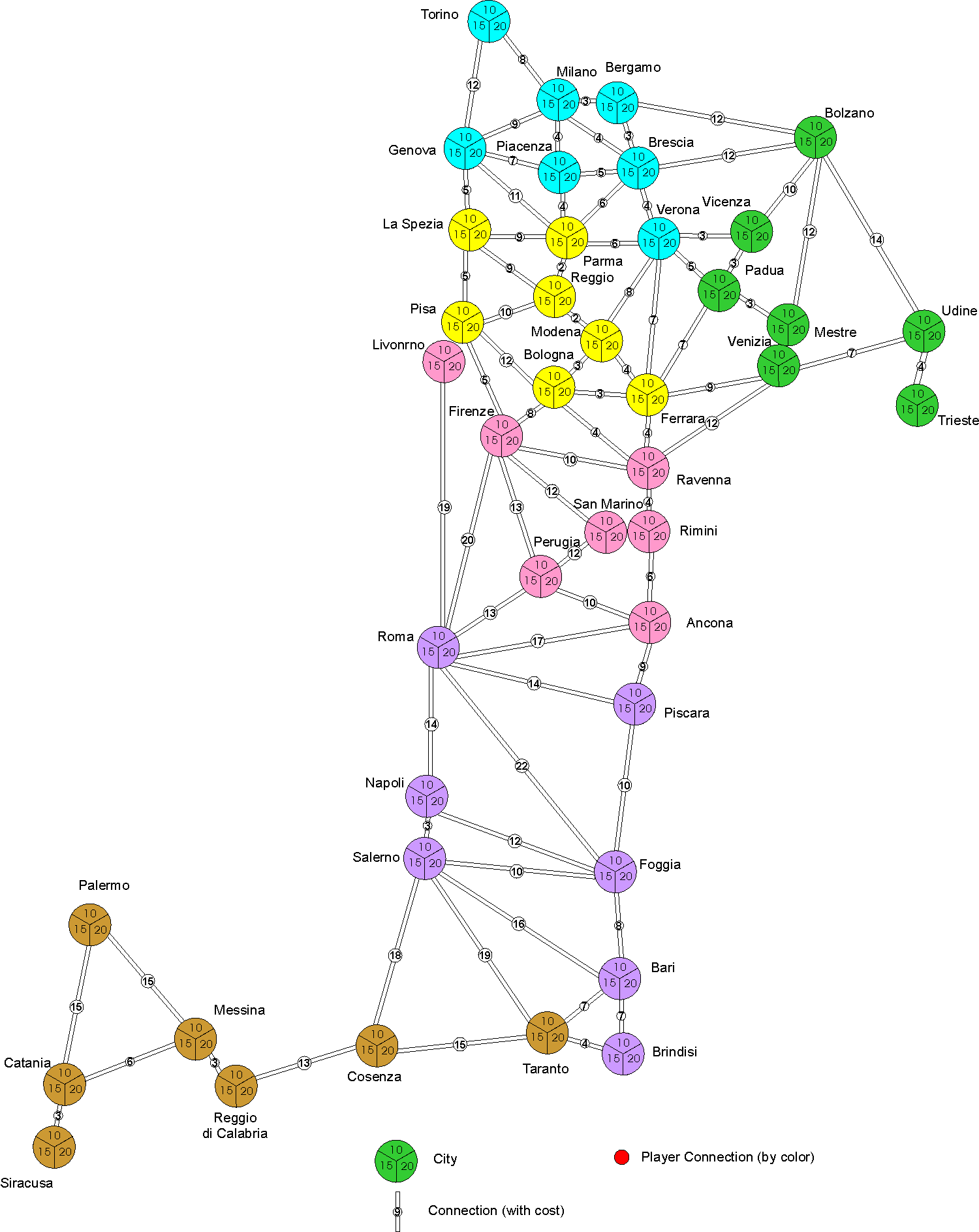
Special Rules for Italy
The initial resource market is set up so that coal is filled down to a price of 3 Elektro, oil to 4 Elektro, waste to 5 Elektro, and uranium to 14 Elektro.
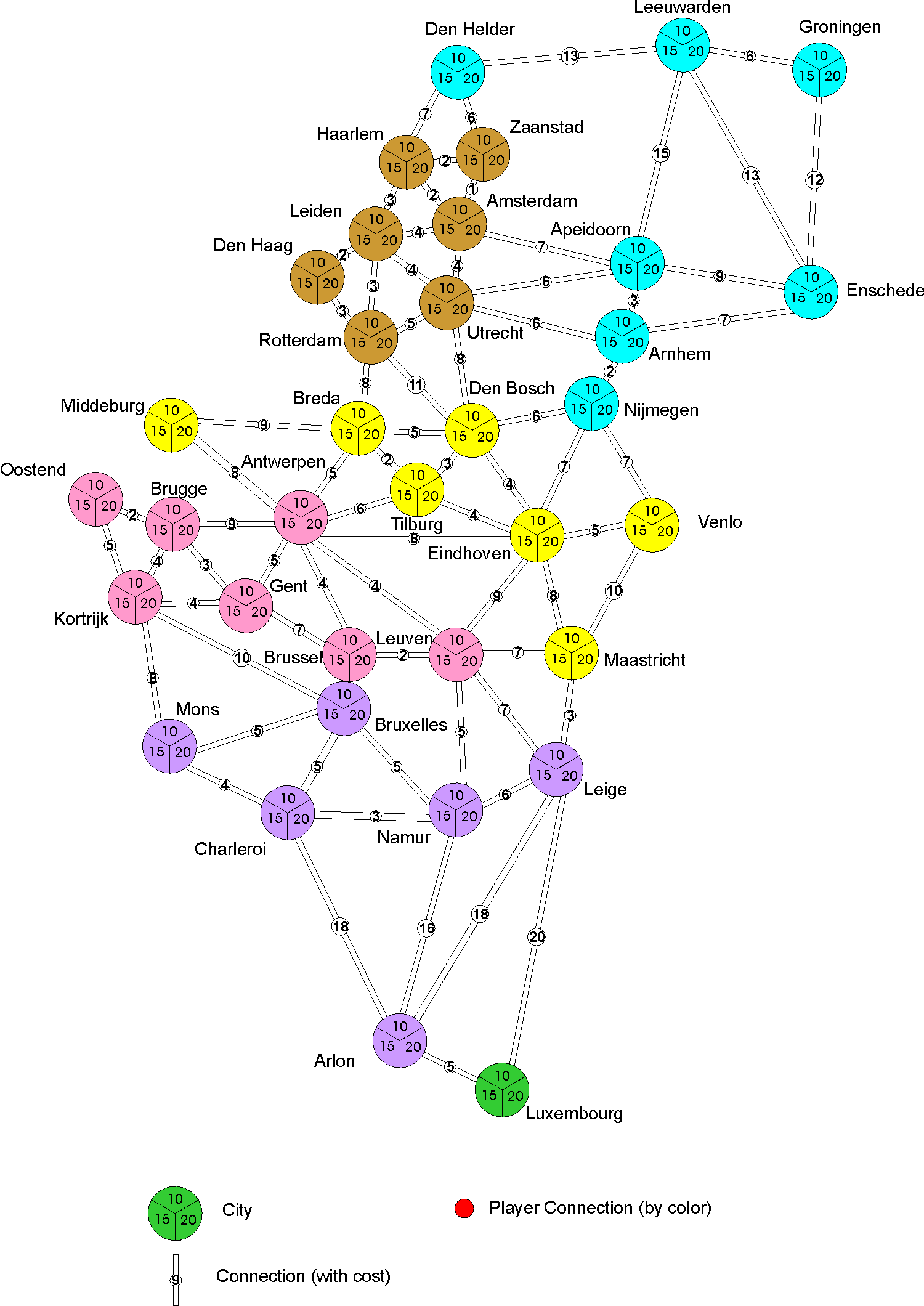
Special Rules for Benelux
1. Initial Resource Setup: Coal to 3, Oil to 1, Waste to 7, and Uranium to 14.
2. Whenever an ecological power plant would be the smallest power plant in the futures market, it is added to the current market, thus temporarily increasing the size of the current market.
3. During the Bureaucracy phase in steps 1 and 2, the smallest power plant is removed from the current market and a new draw is made to replace it. This is in addition to drawing the largest power plant and adding it to the bottom of the deck.
4. Luxembourg (green) is considered to be in the same area as southern Belgium (purple) for purposes of selecting areas that are in play. Thus, this map has only 5 areas instead of the normal six and in five- and six-player games, all areas would be in play.
5. Benelux has its own re-supply table:
|
2 Players |
3 Players |
4 Players |
5 Players |
6 Players |
|||||||||||
|
Step 1 |
Step 2 |
Step 3 |
Step 1 |
Step 2 |
Step 3 |
Step 1 |
Step 2 |
Step 3 |
Step 1 |
Step 2 |
Step 3 |
Step 1 |
Step 2 |
Step 3 |
|
|
Coal |
2 | 2 | 4 | 2 | 3 | 4 | 3 | 4 | 5 | 4 | 5 | 6 | 5 | 6 | 7 |
|
Oil |
3 | 4 | 3 | 4 | 5 | 3 | 5 | 6 | 4 | 5 | 7 | 5 | 7 | 9 | 6 |
|
Garbage |
1 | 2 | 3 | 1 | 2 | 3 | 2 | 3 | 4 | 3 | 3 | 5 | 3 | 5 | 6 |
|
Uranium |
1 | 1 | 1 | 1 | 1 | 1 | 1 | 2 | 2 | 2 | 3 | 2 | 2 | 3 | 3 |
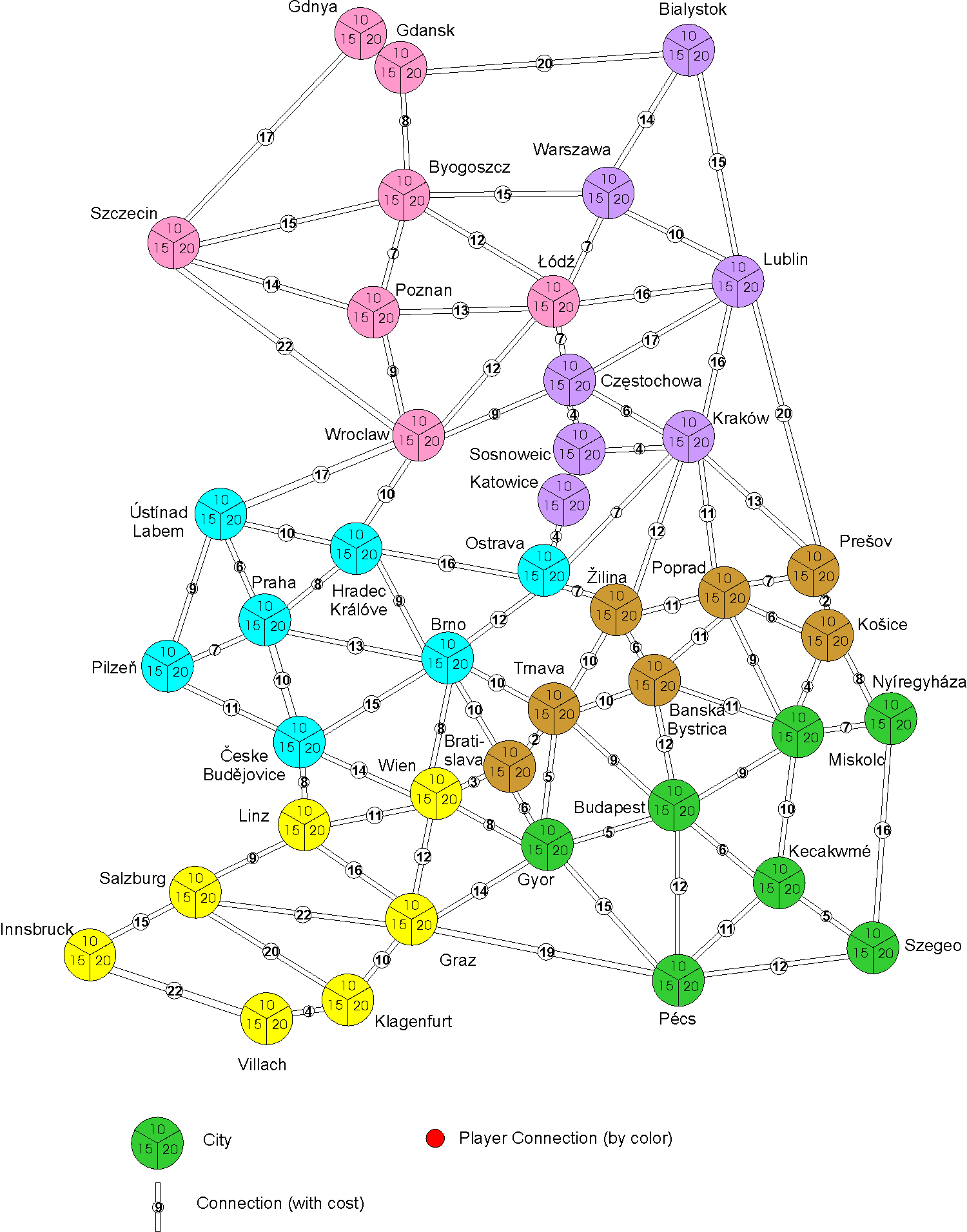
Special Rules for Central Europe
1. The initial resource setup is standard, except for the fact that uranium is populated down to 8.
2. Nuclear power is banned in Poland and Austria, so a player may only bid on or buy a nuclear power plant if his network includes a city in the Czech Republic (blue), Slovakia (brown), or Hungary (green).
3. Any player whose network includes Wien buys waste at a discount of 1 Elektro each (minimum price 1 Elektro).
4. Central Europe has its own re-supply table:
|
2 Players |
3 Players |
4 Players |
5 Players |
6 Players |
|||||||||||
|
Step 1 |
Step 2 |
Step 3 |
Step 1 |
Step 2 |
Step 3 |
Step 1 |
Step 2 |
Step 3 |
Step 1 |
Step 2 |
Step 3 |
Step 1 |
Step 2 |
Step 3 |
|
|
Coal |
4 | 5 | 3 | 5 | 6 | 3 | 6 | 7 | 5 | 7 | 8 | 5 | 8 | 10 | 6 |
|
Oil |
1 | 2 | 3 | 2 | 2 | 3 | 2 | 3 | 4 | 3 | 4 | 5 | 4 | 5 | 6 |
|
Garbage |
1 | 3 | 3 | 1 | 3 | 3 | 2 | 4 | 4 | 3 | 4 | 5 | 3 | 6 | 6 |
|
Uranium |
1 | 1 | 1 | 1 | 1 | 1 | 1 | 2 | 1 | 2 | 2 | 2 | 2 | 3 | 2 |
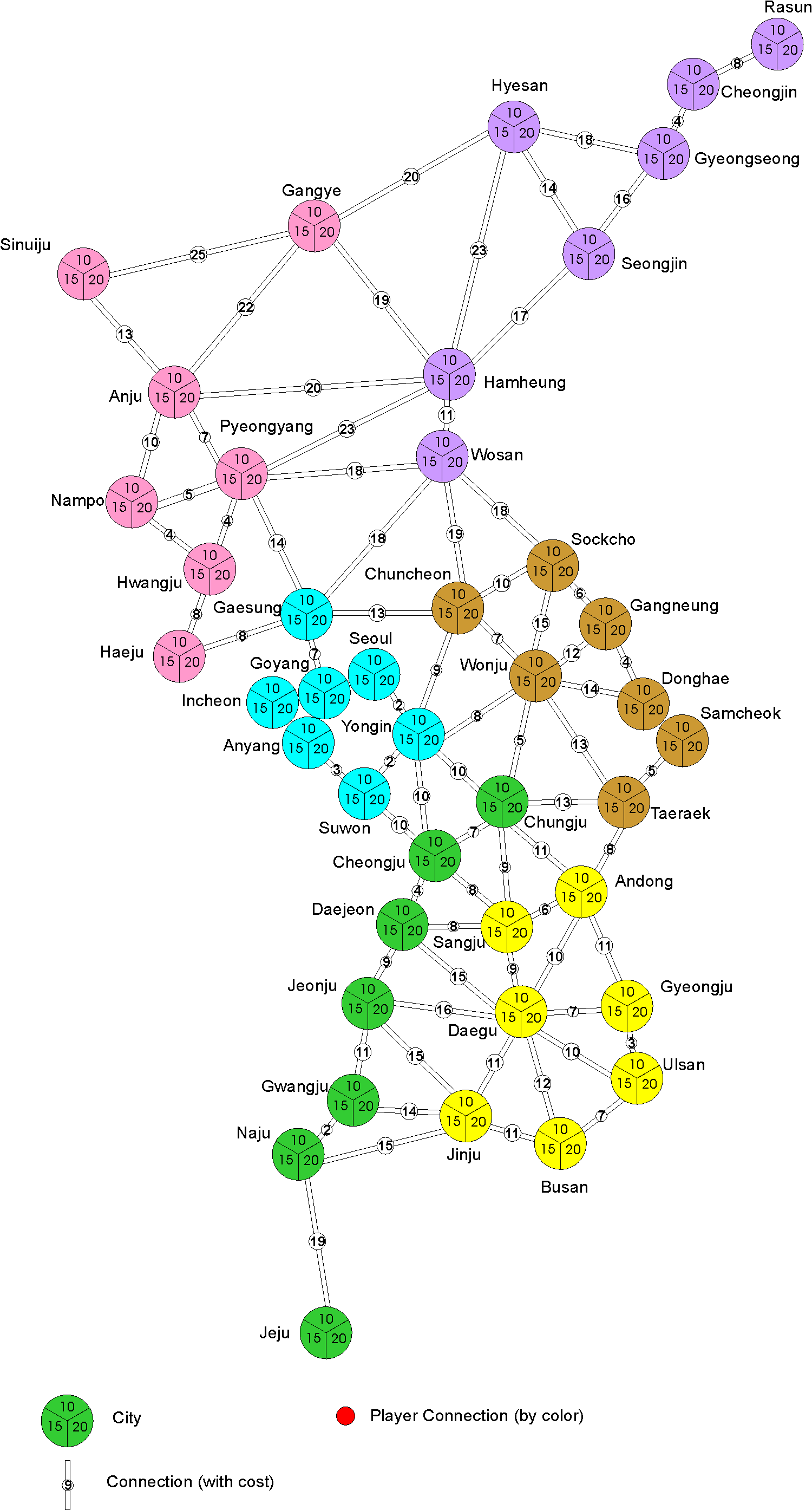
Special Rules for Korea
Korea has two resource markets: one for the North, and one for the South. This is the only way that the division of the peninsula enters the game. The two markets are divided as follows:
The North market has 1 unit available at all prices from 1 to 8 for both oil and waste. For coal, it has 2 units available from prices 1 to 4, and 1 unit available for prices 5 to 8.
The South market has 2 units available at all prices from 1 to 8 for both oil and waste. For coal, it has 1 unit available from prices 1 to 4, and 2 units available for prices 5 to 8. For uranium, it has the standard amount (1 unit available for prices 1 to 8, 10, 12, 14, and 16).
During Preparation, the markets are stocked as follows:
North: coal to 1 Elektro, oil to 3 Elektros, waste to 7 Elektros
South: coal to 1 Elektro, oil to 3 Elektros, waste to 7 Elektros, uranium to 14 Elektros
When buying resources, a player may buy from one market or the other -- never both during a single turn. Resources purchased can be used anywhere, and it does not matter whether a player has cities in the region whose market he is using.
During Bureaucracy, when re-filling markets, if there are insufficient available resources, fill the North market first, and use whatever is remaining to fill the South market.
The re-supply table is as follows:
|
2 Players |
3 Players |
4 Players |
5 Players |
6 Players |
||||||||||||
|
Step 1 |
Step 2 |
Step 3 |
Step 1 |
Step 2 |
Step 3 |
Step 1 |
Step 2 |
Step 3 |
Step 1 |
Step 2 |
Step 3 |
Step 1 |
Step 2 |
Step 3 |
||
|
Coal |
N | 1 | 2 | 1 | 2 | 2 | 1 | 2 | 2 | 2 | 2 | 3 | 2 | 3 | 4 | 3 |
| S | 2 | 2 | 2 | 2 | 3 | 2 | 3 | 2 | 3 | 3 | 4 | 3 | 4 | 5 | 3 | |
|
Oil |
N | 1 | 1 | 1 | 1 | 1 | 1 | 1 | 1 | 2 | 1 | 2 | 2 | 2 | 2 | 3 |
| S | 1 | 1 | 3 | 1 | 2 | 3 | 2 | 3 | 3 | 3 | 3 | 4 | 3 | 4 | 4 | |
|
Garbage |
N | 0 | 1 | 1 | 0 | 1 | 1 | 1 | 1 | 2 | 1 | 1 | 2 | 1 | 2 | 3 |
| S | 1 | 1 | 2 | 1 | 1 | 2 | 1 | 2 | 2 | 1 | 2 | 3 | 2 | 3 | 3 | |
|
Uranium |
N | 0 | 0 | 0 | 0 | 0 | 0 | 0 | 0 | 0 | 0 | 0 | 0 | 0 | 0 | 0 |
| S | 1 | 1 | 1 | 1 | 1 | 1 | 1 | 2 | 2 | 2 | 3 | 2 | 2 | 3 | 3 | |

Special Rules for China
Because China is a centrally planned economy, the way the power plant market functions is very different, with much of the randomness being removed.
Preparation
Depending on the number of players, the following cards are removed from the deck:
2 or 3 players: 3, 4, 9, 11, 16, 18, 20, 24, 30, 33, 46
4 players: 3, 4, 11, 18, 24, 33, 46
5 or 6 players: 3, 4, 33
The remaining cards are sorted into three groups:
plants 36 - 50 are shuffled and placed face down at the bottom of the deck.
plants 31 - 35 and the Step 3 card are shuffled and placed on top of the above group
plants 5 - 30 are placed in order and placed at the top of the deck.
There is no future market. One card per player is drawn and this becomes the available power plant market.
The initial resource supply is as follows:
Coal and oil are filled to 5 Elektros, waste to 7 Elektros, and no uranium is placed at start.
Phase 2: Auction Power Plants
During Steps 1 and 2, as power plants are purchased, they are not immediately replaced. Replacement is only done during the Bureaucracy phase. During Step 3, power plants are replaced as they are purchased as they are in the standard game. If none of the power plants are purchased, the lowest value power plant is not removed.
Phase 4: Building
The scrapping rule is not in effect, so power plants are not removed as the largest player network equals or exceeds the number of the power plant.
When Step 2 is reached, the lowest number power plant is removed and replaced as normal.
Phase 5: Bureaucracy
During Step 1 and 2, the new power plants are drawn to fill the power plant market to a number equal to one less than the number of players (Exception: In a 2 player game, the market should have 2 power plants). However, there is a minimum draw, based on the number of players:
2 or 3 players: 1 power plant
4 or 5 players: 2 power plants
6 players: 3 power plants
The minimum draw is always made, even if it would increase the size of the market beyond the nominal maximum. After the power plants are added, the lowest numbered plants are removed until the appropriate number is reached.
During Step 3, the market always contains 4 power plants, regardless of the number of players. When the Step 3 card is drawn, that card and the lowest numbered power plant in play are removed, and any additional power plants are drawn to make a total of 4 in the market. If there are already 4 in the market, no further cards are drawn. As in the regular game, on subsequent turns, the lowest numbered power plant is removed and replaced during this phase.
China has its own resource re-supply table as follows:
|
2 Players |
3 Players |
4 Players |
5 Players |
6 Players |
|||||||||||
|
Step 1 |
Step 2 |
Step 3 |
Step 1 |
Step 2 |
Step 3 |
Step 1 |
Step 2 |
Step 3 |
Step 1 |
Step 2 |
Step 3 |
Step 1 |
Step 2 |
Step 3 |
|
|
Coal |
4 | 4 | 3 | 5 | 5 | 3 | 6 | 6 | 4 | 7 | 7 | 5 | 9 | 9 | 6 |
|
Oil |
2 | 2 | 4 | 3 | 3 | 4 | 4 | 4 | 5 | 5 | 5 | 6 | 6 | 6 | 7 |
|
Garbage |
2 | 2 | 1 | 2 | 2 | 1 | 3 | 3 | 2 | 3 | 3 | 3 | 5 | 5 | 3 |
|
Uranium |
1 | 1 | 1 | 1 | 1 | 1 | 2 | 2 | 2 | 3 | 3 | 2 | 3 | 3 | 3 |
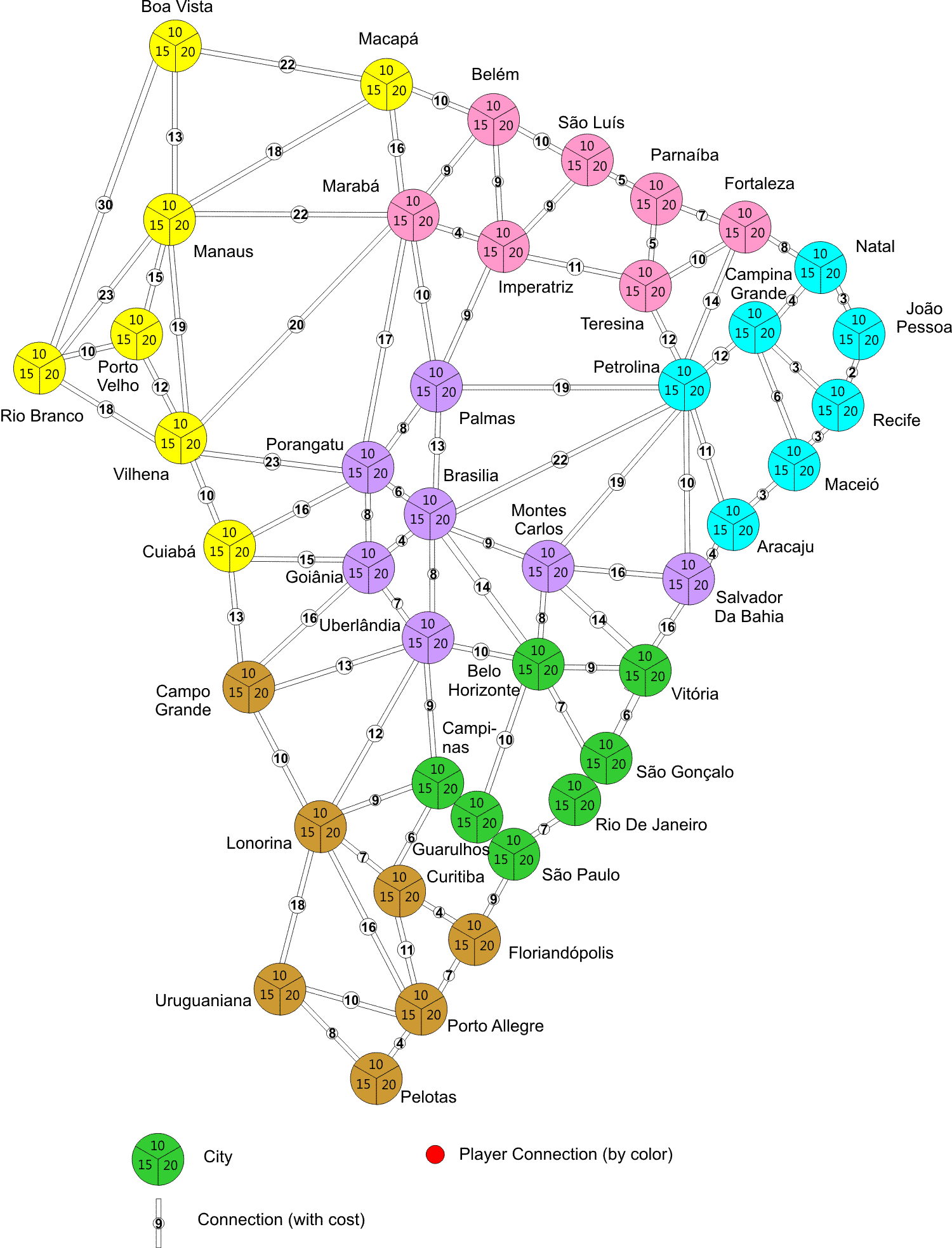
Special Rules for Brazil
While using the Brazil map, all garbage plants are considered biogas plants. Biogas is preferred by Brazillian suppliers of electricity, so during the initial setup, remove all biogas plants from the deck before randomly discarding any power plants. The biogas plants are then shuffled back into the deck. Power plant 14 is then placed directly under power plant 13 at the top of the draw deck. All other rules are standard.
Brazil has its own resource re-supply table as follows:
|
2 Players |
3 Players |
4 Players |
5 Players |
6 Players |
|||||||||||
|
Step 1 |
Step 2 |
Step 3 |
Step 1 |
Step 2 |
Step 3 |
Step 1 |
Step 2 |
Step 3 |
Step 1 |
Step 2 |
Step 3 |
Step 1 |
Step 2 |
Step 3 |
|
|
Coal |
1 | 2 | 3 | 1 | 2 | 3 | 2 | 3 | 4 | 3 | 3 | 5 | 3 | 5 | 6 |
|
Oil |
3 | 4 | 3 | 4 | 5 | 3 | 5 | 6 | 4 | 5 | 7 | 5 | 7 | 9 | 6 |
|
Biogas |
2 | 2 | 4 | 2 | 3 | 4 | 3 | 4 | 5 | 4 | 5 | 6 | 5 | 6 | 7 |
|
Uranium |
1 | 1 | 1 | 1 | 1 | 1 | 1 | 2 | 2 | 2 | 3 | 2 | 2 | 3 | 3 |
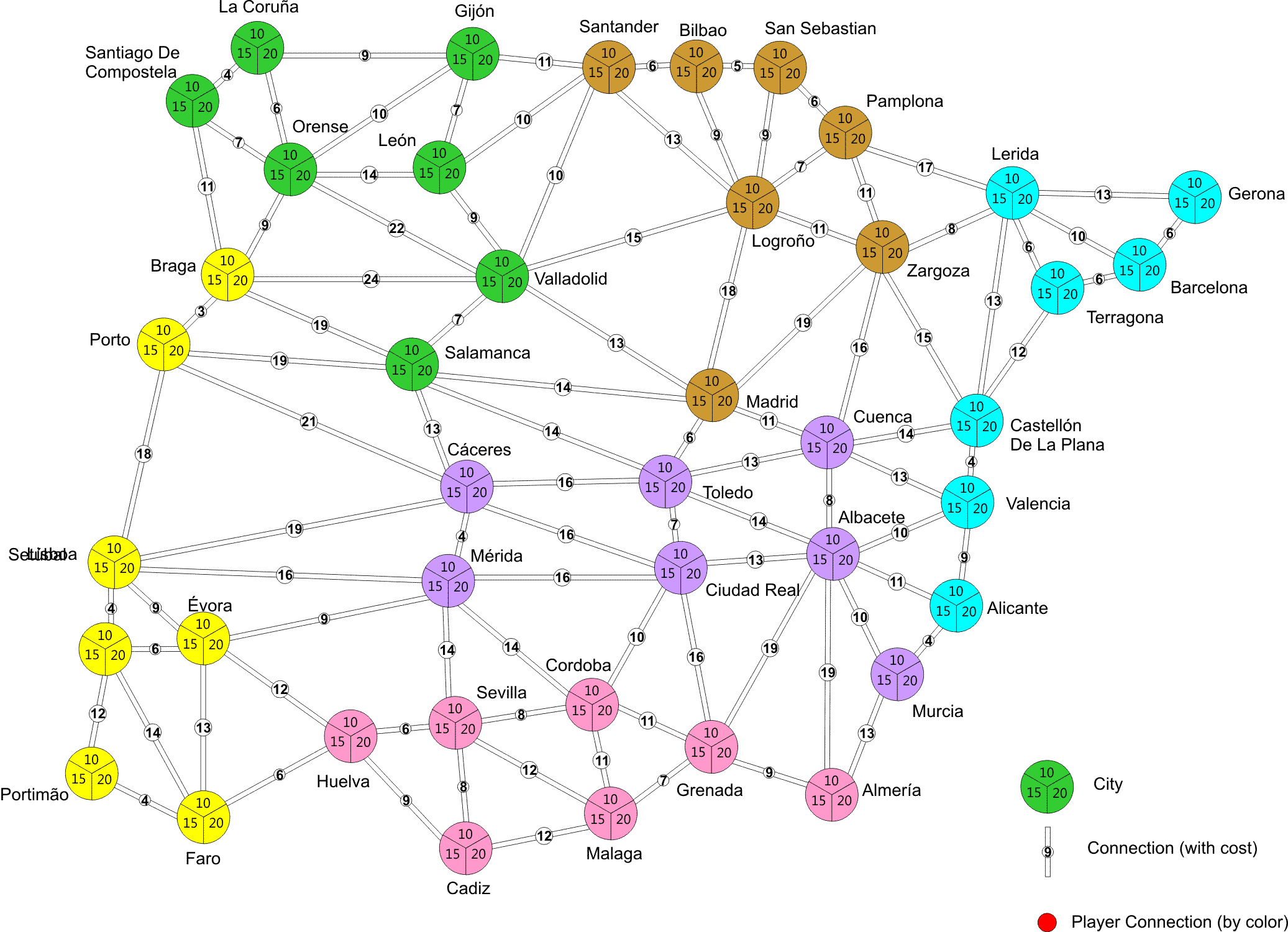
Special Rules for Spain and Portugal
During the initial preparation, power plants 18, 22, and 27 are sorted out from the deck and set aside. Resources are filled as follows: coal at 1, oil at 3, garbage at 6, and uranium at 5.
Players with networks only in Portugal (the yellow cities) may not bid on nuclear plants.
At the start of Step 2, power plants 18, 22, and 27 are placed (in that order) at the top of the draw deck. This happens before the replacement draw, thus power plant 18 will be drawn to replace the smallest power plant removed at the beginning of Step 2.
Spain and Portugal has its own resource re-supply table as follows:
|
2 Players |
3 Players |
4 Players |
5 Players |
6 Players |
|||||||||||
|
Step 1 |
Step 2 |
Step 3 |
Step 1 |
Step 2 |
Step 3 |
Step 1 |
Step 2 |
Step 3 |
Step 1 |
Step 2 |
Step 3 |
Step 1 |
Step 2 |
Step 3 |
|
|
Coal |
3 | 4 | 2 | 4 | 5 | 2 | 4 | 6 | 3 | 4 | 7 | 3 | 6 | 8 | 4 |
|
Oil |
2 | 3 | 5 | 2 | 4 | 5 | 3 | 5 | 6 | 4 | 6 | 7 | 5 | 7 | 9 |
|
Garbage |
1 | 2 | 3 | 1 | 2 | 3 | 2 | 3 | 4 | 3 | 3 | 5 | 3 | 5 | 6 |
|
Uranium |
0 | 2 | 1 | 0 | 2 | 1 | 0 | 4 | 1 | 0 | 5 | 1 | 0 | 5 | 2 |
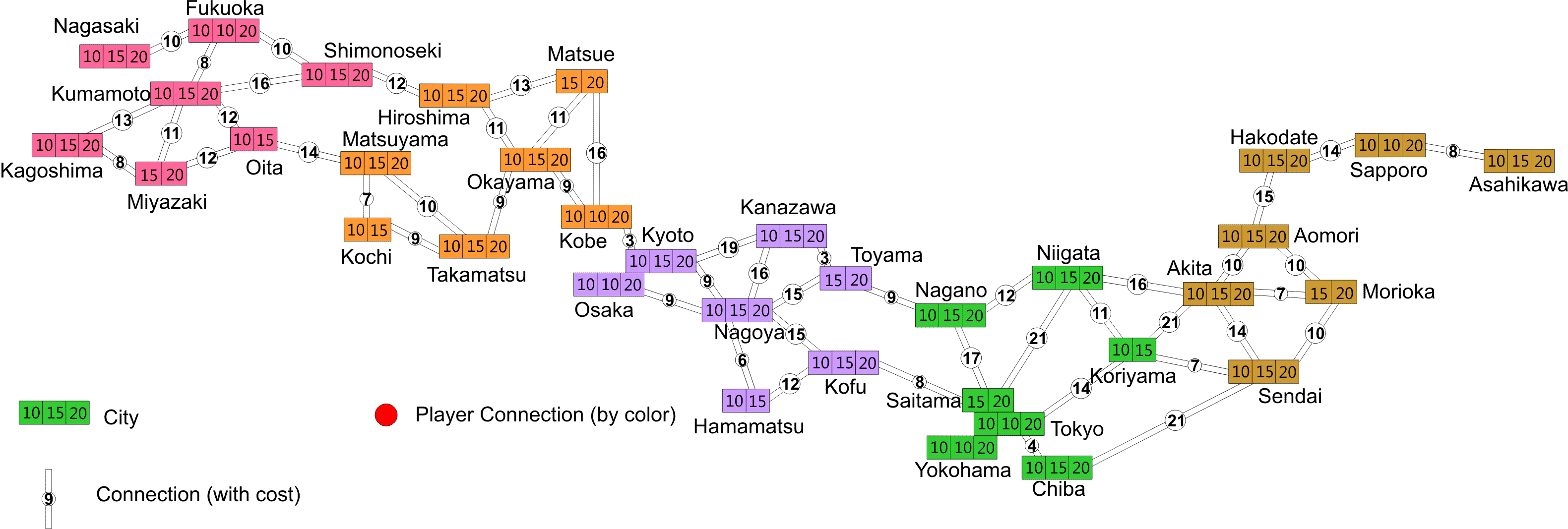
Special Rules for Japan
During the initial preparation, resources are filled as follows: coal at 2, oil at 4, garbage at 6, and uranium at 12.
Players may start with two non-connected networks. All networks must start from one of the following cities: Fukuoka, Kobe, Osaka, Sapporo, Tokyo, or Yokohama. These cities have two "10" spots to signify this. A player may start his second network at any time, so long as there is an available spot at any of those cities (including the "20" spot). If all available spots at those cities are occupied, no new networks may be started.
Note that some cities in Japan are smaller than normal and only two players may occupy them. All spots with a cost of 15 become available during Step 2 and all those with a cost of 20 become available in Step 3.
Japan has its own resource re-supply table as follows:
|
2 Players |
3 Players |
4 Players |
5 Players |
6 Players |
|||||||||||
|
Step 1 |
Step 2 |
Step 3 |
Step 1 |
Step 2 |
Step 3 |
Step 1 |
Step 2 |
Step 3 |
Step 1 |
Step 2 |
Step 3 |
Step 1 |
Step 2 |
Step 3 |
|
|
Coal |
3 | 4 | 3 | 4 | 5 | 3 | 5 | 6 | 4 | 5 | 7 | 5 | 7 | 9 | 6 |
|
Oil |
2 | 2 | 4 | 2 | 3 | 4 | 3 | 4 | 5 | 4 | 5 | 6 | 5 | 6 | 7 |
|
Garbage |
1 | 2 | 3 | 1 | 2 | 3 | 2 | 3 | 4 | 3 | 3 | 5 | 3 | 5 | 6 |
|
Uranium |
1 | 1 | 1 | 1 | 1 | 1 | 1 | 2 | 2 | 2 | 3 | 2 | 2 | 3 | 3 |
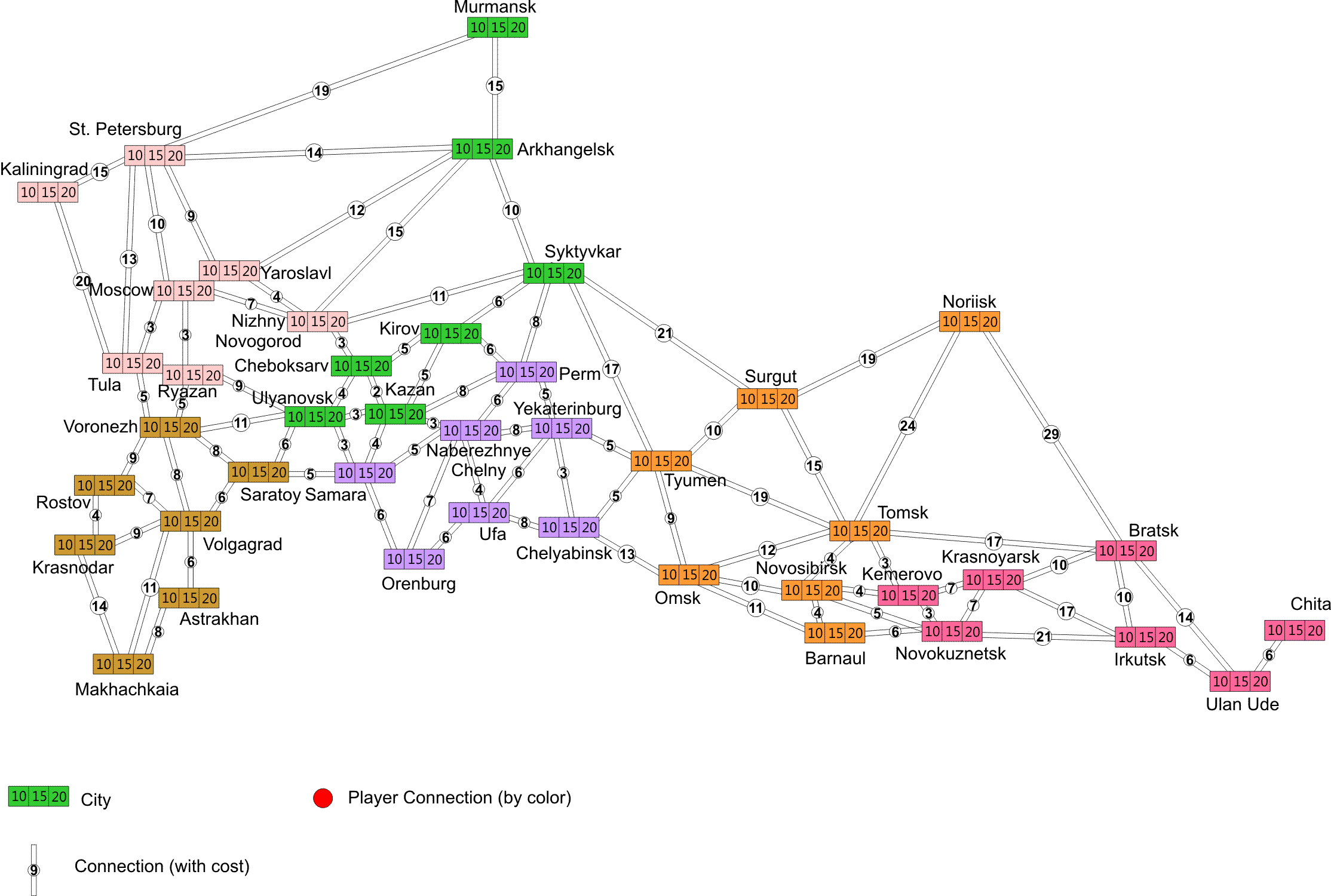
Special Rules for Russia
During the initial preparation, power plants 6 and 14 are removed from the game. The power plant market contains only 6 power plants -- 3 in the current market and 3 in the future market. At start, power plants 3, 4, and 5 are in the current market and 7, 8, and 9 in the future market. At the start, power plants 10, 11, and 13 are set aside. The remaining power plants are prepared as usual. The top three cards are shuffled together with power plants 10 and 11 and placed back on the top of the stack, then power plant 13 is placed on top of them. Resources are filled as follows: coal at 3, oil at 1, and uranium at 6. There is no garbage at the start of the game.
Phase 2: Auction Power Plants
Starting on game turn 2, when the first player passes, remove the smalled power plant from the market and draw to replace it. This replaces the rule that the smallest power plant is removed when all players pass.
Phase 4: Building
Do not remove a power plant when a player connects the same or a higher number of cities in his network.
Game Step 3
Due to the restricted market size, there will only be four power plants available during this step.
Russia has its own resource re-supply table as follows:
|
2 Players |
3 Players |
4 Players |
5 Players |
6 Players |
|||||||||||
|
Step 1 |
Step 2 |
Step 3 |
Step 1 |
Step 2 |
Step 3 |
Step 1 |
Step 2 |
Step 3 |
Step 1 |
Step 2 |
Step 3 |
Step 1 |
Step 2 |
Step 3 |
|
|
Coal |
2 | 2 | 4 | 2 | 3 | 4 | 3 | 4 | 5 | 4 | 5 | 6 | 5 | 6 | 7 |
|
Oil |
3 | 4 | 3 | 3 | 4 | 3 | 5 | 6 | 4 | 5 | 7 | 5 | 7 | 9 | 6 |
|
Garbage |
2 | 2 | 3 | 2 | 2 | 3 | 3 | 3 | 4 | 4 | 3 | 5 | 4 | 5 | 6 |
|
Uranium |
1 | 1 | 1 | 1 | 1 | 1 | 1 | 2 | 2 | 2 | 3 | 2 | 2 | 3 | 3 |

Special Rules for Quebec
During the initial preparation, set aside power plants 13, 18, and 22, then prepare the deck as normal, except ecological power plants are never removed. Then, place the three set aside plants on top of the deck in order with 13 on top. Resources are filled as follows: coal at 2, oil at 2, garbage at 7, and uranium at 14.
During the game, ecological power plants are only removed from the market when purchased, or when a player connects cities equal to the value of the plant.
Phase 5: Bureaucracy
When placing the highest power plant on the bottom of the deck, do not take an ecological power plant. Instead, take the next highest power plant.
Quebec has its own resource re-supply table as follows:
|
2 Players |
3 Players |
4 Players |
5 Players |
6 Players |
|||||||||||
|
Step 1 |
Step 2 |
Step 3 |
Step 1 |
Step 2 |
Step 3 |
Step 1 |
Step 2 |
Step 3 |
Step 1 |
Step 2 |
Step 3 |
Step 1 |
Step 2 |
Step 3 |
|
|
Coal |
3 | 3 | 3 | 4 | 4 | 3 | 5 | 4 | 4 | 5 | 5 | 5 | 7 | 6 | 6 |
|
Oil |
2 | 2 | 3 | 2 | 3 | 3 | 3 | 4 | 4 | 4 | 5 | 4 | 5 | 6 | 5 |
|
Garbage |
1 | 2 | 3 | 1 | 2 | 3 | 2 | 3 | 4 | 3 | 3 | 5 | 3 | 5 | 6 |
|
Uranium |
1 | 1 | 1 | 1 | 1 | 1 | 1 | 2 | 2 | 2 | 3 | 2 | 2 | 3 | 3 |

Special Rules for Baden-Wuerttemburg
On the board, the turn order is changed. Buying plants comes first, then player order is determined. Resources are filled as for Germany.
Phase 1: Auction Power Plants
If no power plant is sold, the two lowest numbered power plants are removed.
Phase 3: Building
Each region has a city with only two build spots (such as Basel and Strasbourg). These become available for building during Step 2. Power plants are not removed when a player connects that number or greater of cities.
Phase 5: Bureaucracy
Step 2 begins after the first player connects to 9 cities in 2 player games, 6 cities in 3 to 5 player games, and 5 cities in 6 player games.
Baden-Wuerttemburg has its own resource re-supply table as follows:
|
2 Players |
3 Players |
4 Players |
5 Players |
6 Players |
|||||||||||
|
Step 1 |
Step 2 |
Step 3 |
Step 1 |
Step 2 |
Step 3 |
Step 1 |
Step 2 |
Step 3 |
Step 1 |
Step 2 |
Step 3 |
Step 1 |
Step 2 |
Step 3 |
|
|
Coal |
3 | 4 | 3 | 4 | 5 | 3 | 5 | 6 | 4 | 5 | 7 | 5 | 7 | 9 | 6 |
|
Oil |
2 | 2 | 4 | 2 | 3 | 4 | 3 | 4 | 5 | 4 | 5 | 6 | 5 | 6 | 7 |
|
Garbage |
1 | 2 | 3 | 1 | 2 | 3 | 2 | 3 | 4 | 3 | 3 | 5 | 3 | 5 | 6 |
|
Uranium |
1 | 1 | 1 | 1 | 1 | 1 | 1 | 2 | 2 | 2 | 3 | 2 | 2 | 3 | 3 |
|
Number |
Type |
Inputs |
Output |
|
1 |
Coal |
3 |
1 |
|
2 |
Oil |
2 |
1 |
|
3 |
Coal |
1 |
1 |
|
4 |
Hybrid |
1 |
1 |
|
5 |
Hybrid |
3 |
2 |
|
6 |
Garbage |
1 |
2 |
|
7 |
Oil |
2 |
2 |
|
8 |
Nuclear |
1 |
2 |
|
9 |
Coal |
3 |
3 |
|
10 |
Ecological |
N/A |
1 |
|
11 |
Ecological |
N/A |
1 |
|
12 |
Oil |
1 |
2 |
|
13 |
Hybrid |
1 |
2 |
|
14 |
Coal |
3 |
4 |
|
15 |
Ecological |
N/A |
2 |
|
16 |
Ecological |
N/A |
2 |
|
19 |
Nuclear |
1 |
3 |
|
20 |
Oil |
1 |
3 |
|
21 |
Garbage |
3 |
5 |
|
22 |
Oil |
2 |
4 |
|
23 |
Coal |
2 |
4 |
|
24 |
Nuclear |
1 |
4 |
|
25 |
Oil |
3 |
5 |
|
26 |
Ecological |
N/A |
3 |
|
27 |
Garbage |
1 |
4 |
|
28 |
Coal |
3 |
5 |
|
29 |
Hybrid |
3 |
5 |
|
30 |
Coal |
1 |
4 |
|
31 |
Nuclear |
1 |
5 |
|
32 |
Ecological |
N/A |
4 |
|
33 |
Garbage |
2 |
5 |
|
34 |
Coal |
3 |
6 |
|
35 |
Coal |
1 |
5 |
|
36 |
Hybrid |
2 |
6 |
|
37 |
Oil |
3 |
7 |
|
38 |
Nuclear |
1 |
6 |
|
39 |
Ecological |
N/A |
5 |
|
40 |
Oil |
1 |
6 |
|
42 |
Garbage |
2 |
7 |
|
44 |
Fusion |
N/A |
6 |
|
46+ |
Coal |
2 |
7 |
|
50+ |
Nuclear |
2 |
8 |
| 52+ | Garbage | 3 | 8 |
| 54+ | Oil | 2 | 8 |
| 57+ | Oil | 3 | 9 |
| 60+ | Nuclear | N/A | 8 |
There are four ways this new deck can be used.
Variant 1: Power Grid with the New Power Plant Deck
The game proceeds as usual, except that power plants 1 through 8 form the initial markets. Power plant 11 is set aside and placed on the top of the shuffled deck. Cards 46 through 60 are not used.
If playing with the France map, simply remove power plant 11 from the game.
If playing with the China map, the following cards are removed, depending on the number of players:
2 or 3 players: 1, 2, 4, 8, 12, 14, 15, 21, 32, 33, 36
4 players: 1, 2, 8, 14, 15, 21, 32, 36
5 or 6 players: 1, 2, 32
The bottom part of the deck is composed of cards 35 through 44, shuffled. On top of them, place cards 29 through 34 and the Step 3 card, shuffled. The top part of the deck is comprised of the remaining cards in order.
If playing with the Brazil map, place power plant 21 below power plant 10 at the top of the draw deck.
If playing with the Spain and Portugal or the Quebec maps, set aside power plants 11, 15, and 16. These will be placed at the top of the draw deck at the start of Step 2.
If playing with the Russia map, remove power plant 6 from the game. Set power plants 8, 9, and 11 aside, then prepare the deck normally. Take the top three cards, and shuffle cards 8 and 9 with them, placing them on top of the draw pile, with card 11 on top of them.
Variant 2: Power Grid with Both Power Plant Decks
Once again, cards 46 through 60 in the new deck are not used.
Set aside cards 1 through 8 from the new deck and cards 3 through 8 from the original deck. These are shuffled together. Draw from that pile, removing the first card drawn of each number (except 1 and 2, which have no counterpart in the original deck). Shuffle the remaining cards except for the Step 3 card, and place the Step 3 card at the bottom of that deck. During the game, remove the first card drawn of each power plant number and place it in a separate pile, which is available for inspection by the players at any time. Depending on the number of players, if the deck needs to be pared down, simply continue to draw until the first four or eight duplicate power plant numbers are drawn. The duplicates are set aside in a different pile. Power plants that are removed from play are also placed in this pile.
This variant is not recommended for use with the China map.
Variant 3: Power Grid+ with a Big Power Plant Deck
In this variant, add cards 46 through 60 from the new deck to either the new or the old decks. If using the old deck, power plants 46+ and 50+ are considered to have higher numbers than their counterparts in that deck. In this variant, depending on the number of players, the following adjustments are made:
|
Players |
Total Cities in Play |
Step 2 Threshold |
Game End Threshold |
Power Plants Removed At Game Start |
| 2 | 24 | 12 | 24 | 10 |
| 3 | 24 | 8 | 20 | 10 |
| 4 | 32 | 8 | 20 | 5 |
| 5 | 40 | 8 | 18 | 0 |
| 6 | 42 | 7 | 15 | 0 |
The standard region arrangement does not work for this variant, players should select a contiguous group of cities (12 cities in a 2 player game, 8 cities in a 3, 4, or 5 player game) they want in play, and any cities not in play will be appropriately marked. In a 6 player game, all cities are in play. Note that this variant is not possible on the Benelux, Japan, or Baden-Wuerttemburg maps with 5 or 6 players. For the China map, the "+" power plants are shuffled in with the 36-50 numbered plants and placed on the bottom of the deck.
Variant 4: Power Grid with a Designer Deck
In this variant, the GM will create a deck using power plants from both decks. The power plants used are entirely at the discretion of the GM.
Energy Crisis is a variant that adds cards to the deck that can alter how the game works. It also adds new types of power plants and slightly alters how existing power plants work. The details are in the two PDF files. The first contains the rules, the second contains the new cards.
This variant can be used with any of the maps or deck variants above.
The notation for the new items will be as follows:
Bills and Ideas will be identified by name (e.g. 04 No Nukes Campaign, 38 Cracked Coal)
Other power plants will be identified as follows:
Solar: XX* Solar X→N (XX is power plant number, * indicates a starred card, N is number of cities powered)
Geothermal: XX Geo (Y)→N (XX is power plant number, Y is cost (paid during Phase 4), and N is number of cities powered)
Natural Gas: XX Gas Y→N (XX is power plant number, Y is multiple of oil price paid to operate, N is number of cities powered)
Biofuel: XX Bio Y→N (XX is power plant number, Y is multiple of trash price paid to operate, N is number of cities powered)
Reservoir: XX Res Y→N (XX is power plant number, Y is base storage number, N is the number of cities powered by the base storage number)
Hydro: XX Hydro Y→N (XX is the power plant number, Y is the number of river cities needed to operate, N is the number of cities it powers)
Warehouse: 07* Warehouse
Coal Mine: 12* Coal Mine
Oil Derrick: 14* Oil Derrick
Recycling Plant: 17* Recycling Plant
The Promotion cards are a set of cards that are
shuffled into the deck after the appropriate number of cards has been
removed. As such, it is not appropriate for play on the China
map, but is OK for all other maps. They consist of the following
cards:
| Cash |
Taxes |
| 0-4 Elektros |
0 Elektro |
| 5-9 Elektros |
1 Elektro |
| 10-14 Elektros |
2 Elektro |
| 15-19 Elektros |
3 Elektro |
| ... |
... |